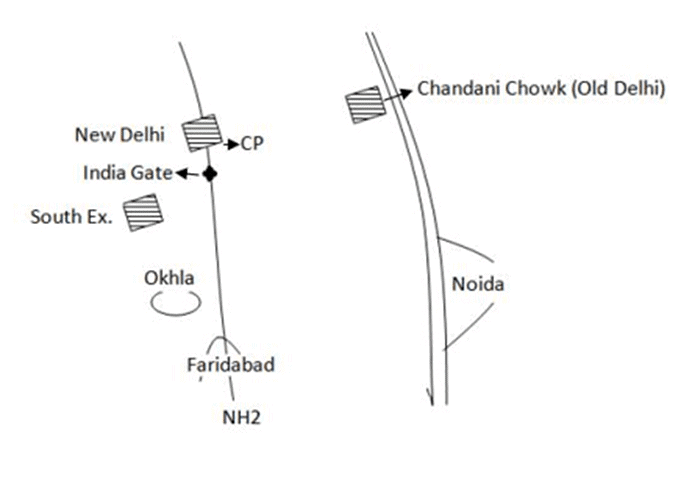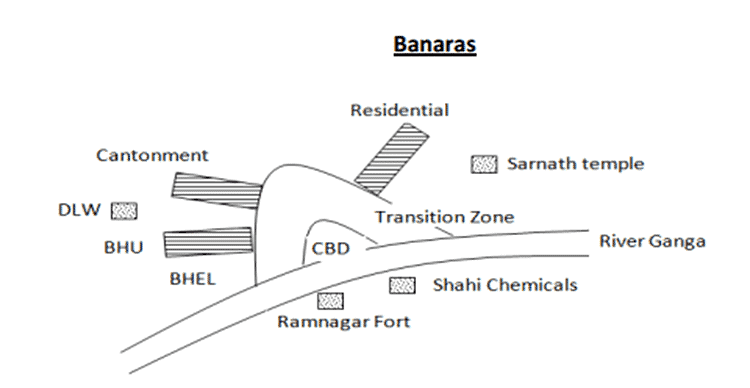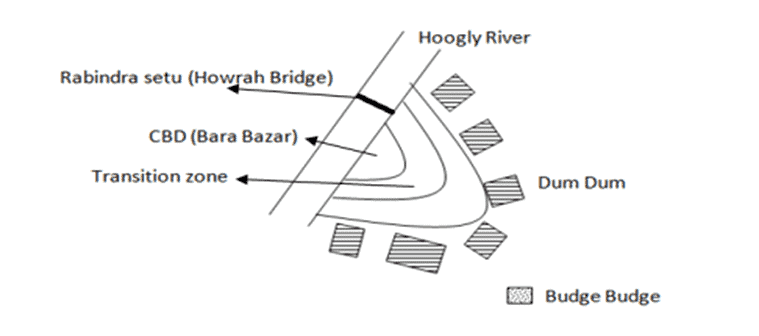Morphology of Indian cities | Geography Optional for UPSC PDF Download
Urban Morphology of Indian Cities
The urban morphology of Indian cities has evolved over a long period and can be characterized by various features reflecting their development during different historical phases. These cities often exhibit a dual structure, blending indigenous elements with Western-style structures or hybridized European features.
- For instance, Kolkata is functionally similar to a Western city, but it is more compact than any West-European city of the same population. Allahabad, on the other hand, is densely populated and unplanned, with narrow streets in contrast to the grid-planned Civil Lines area. The railway area in Allahabad acts as a divide between the crowded old city and the more systematically planned cantonment and civil lines.
- The impact on the morphology of Indian cities is primarily social, with the urban landscape featuring both traditional and modern areas. Many cities in India, like Delhi, have an old walled city with a moat, which has now been replaced by post-independence development. The remnants of these old cities reflect high-density buildings, irregular street patterns, and mixed land use.
- Residential units in these indigenous cities are often deeply ingrained by caste and community quarters. Meanwhile, areas that were developed during the British rule, such as Connaught Place in Delhi, feature European-style buildings, modern shops, and offices. This blend of different urban scenes is a common feature in the morphology of Indian cities.
- Since gaining independence, many Indian cities have continued to adopt Western urbanism in various aspects of political, economic, cultural, and social life. This influence is more dramatic in metro cities and subtle in medium-sized towns. City walls, which were once a symbol of protection, are now being demolished to give way to new business markets, spacious roads, and multi-storied buildings.
- Geographers like Garrison, Kusum Lata, John E. Bush, and Prof. Ashok Dutta have conducted significant research on the morphology of Indian cities. Garrison's "Fused Growth Theory on Urban Morphology," in particular, has become a model for studying modern metro cities in South Asia. This theory outlines three trends: concentric growth of towns up to 1990, sectoral growth between 1900 and 1950 due to transportation development, and multi-nuclei growth after 1950. However, Garrison's model has been criticized for being applicable only to large-sized towns and not all towns.
In conclusion, the urban morphology of Indian cities is a complex blend of indigenous and Western influences, reflecting the various historical phases of their development. This dual structure is a unique feature of Indian cities, showcasing the impact of social, cultural, and economic factors on their growth and evolution.
Mrs Kusum Lata’s work:
Mrs. Kusum Lata's research focuses on the morphology of Indian towns, which can be divided into planned, unplanned, and planned cum unplanned towns.
- Planned Towns: These towns, such as Chandigarh and Gandhinagar, are designed with a specific layout, usually following a rectangular or grid pattern for settlements and roads.
- Unplanned Towns: These towns are more common in India and are characterized by their disorganized growth. This haphazard development can be attributed to several factors, including:
- Historical and genetic influences
- The transformation of villages into towns
- Significant migration from rural to urban areas
- The tendency for infrastructure to be built after the establishment of built-up areas, which is the opposite of what typically occurs in Western countries
- The growth of slums and informal settlements
- The preference of Indian people to live near central business districts
- Planned cum Unplanned Towns: These towns consist of two distinct urban morphologies within a defined municipal area. The planned areas generally have a colonial history, while the unplanned areas are the older parts of the city. An example of this can be seen in Delhi, where Connaught Place (planned) and the Red Fort area (unplanned) coexist. This type of urban structure is characteristic of all colonial cities in India.
Professor Ashok Dutta’s Work on Morphology of Indian cities
- Professor Ashok Dutta's research on the morphology of Indian cities focused on two main aspects: the nature of Central Business Districts (CBD) and residential segregation.
- Unlike Western CBDs, Indian CBDs are quite distinct. Only four Indian cities - Mumbai, Delhi, Kolkata, and Chennai - have CBDs that resemble those in the West, with high activity during the day and deserted at night. In most other Indian towns, the CBD is not solely a market zone; it is also characterized by a high population density. This shows the inclination of Indian society to reside within the CBD.
- For instance, Delhi serves as a case study for a medieval and quasi-planned town. It has two nuclei - the pre-industrial nucleus (Chandani Chowk) and the modern nucleus (modern nucleus). The multiple nuclei model can be applied to Delhi, which has recently seen the emergence of new CBDs such as South Extension (VII), heavy manufacturing areas (VI) like Okhla and Nangoli, and residential suburbs (VIII) including Sonipat, TDICD, and DLF City.
- In summary, Professor Ashok Dutta's work highlights the unique nature of Indian CBDs compared to their Western counterparts and the tendency of Indian society to live within these central areas. The case of Delhi exemplifies the different nuclei and the emergence of new CBDs and residential areas in the city.
 Morphology of Indian Cities
Morphology of Indian Cities
Internal structure of Indian cities
- Internal structure can be understood by classificatory approach because Indian cities not only have various level of development but also history of origin.
- Structure of Indian cities based on history of origin:
- Ancient Cities – Varanasi, Kanchipuram, Gaya etc.
- Medieval Cities – Delhi, Agra, Ahmadabad, Allahabad, Shahjanabad, etc.
- Modern Cities – Noida, Chandigarh, Vishakhapatnam (these cities have been developed on the lines of British administrative requirements and have places such as Ghanta Ghar, Civil Lines, Cantonment)
- Structure of Indian cities based on level of development
- Unplanned City – Patna, Banaras
- Quasi-Planned – Delhi, Kolkata, Lucknow, Mumbai, Bangalore
- Planned – Chandigarh, Noida, Jaipur.
Colonial Principles of Planning
In colonial planning, various patterns were utilized to design and develop cities and towns. These patterns are as follows:- Spider web pattern: This planning style can be seen in cities like Delhi and Canberra. It involves the development of settlements in concentric circles, resembling a spider web.
- Rectangular pattern: This pattern is commonly found in industrial towns such as Tata Nagar, Chennai, and Kolkata. The planned sections of these cities are designed with rectangular grids.
- Radial Pattern: A prime example of this planning style is Mumbai, where the city has been developed along the coast in a radial pattern, with roads and streets radiating outwards from a central point.
- Semi-circular pattern: Cities like West Patna, Kochi, and Meerut exhibit this type of planning. In these cities, the layout follows a semi-circular shape, often adapting to the natural landscape or other geographical constraints.
- Organic Morphology: This planning approach focuses on the topography of the site, allowing the natural landscape to dictate road development in hill towns and plateau towns. Examples of this can be seen in Melbourne and various hill stations.
Case study of Banaras (Ancient City)
- It represents ancient and unplanned structure of Indian cities. It is reflective of Burgess Model.
- Central Business District
- It consists of a temple and wholesale retail market.
- It has places for both residential and commercial purposes. The roads are narrow and meandering roads with poor drainage system
- It has tendency of congregation of shops in an area/road. E.g. brass, cloth market, utensils etc.
- The lanes are the area with high economic activity.
- Transition zone
- It consists of light manufacturing industries and weavers housings.
- Handicraft, bidi making industries can be found in this region
- Roads are narrow and congested.
- Middle class housing
- This is the area with greater social cohesion. There is no class differentiation.
- There is utopian residential housing with socialist pattern
- The out fringe has development of institutional areas, heavy industries, air port, educational areas etc.
- Independent nucleation
- There are independent nucleated settlements that has developed around city such as Ramgarh fort, Shahi Chemical, Sarnath temple, Diesel Locomotive Works.
 Case study of Banaras
Case study of Banaras
Case Study of Kolkata
- Kolkata, a large metropolitan city located along the Hooghly River and east of Howrah Bridge, rose to prominence with the arrival of Europeans around 1750. Between 1750 and 1850, the city's growth can be observed in two concentric zones, with the Bara Bazaar area emerging as the Central Business District (CBD).
- Surrounding the CBD is a zone of transition, where various activities take place, such as residential, marketing, storage, and social centers. A third concentric zone developed to accommodate the city's low-income population.
- Following the 1990s, due to sectoral growth, areas with specialized functions began to emerge, primarily for industrial and residential purposes. After 1950, independent urban settlements formed around the main city, such as Dum Dum, which became known for its high-income residential areas and airport, and Budge Budge in the south. This model of development can also be applied to religious and historical cities.
 Case study of Kolkata
Case study of Kolkata
Conclusion
In conclusion, the urban morphology of Indian cities is a complex and unique mixture of indigenous and Western influences, reflecting different historical phases of development. The internal structure of these cities varies based on their history of origin and level of development, showcasing both planned and unplanned towns with diverse planning patterns. The research of scholars like Garrison, Kusum Lata, and Ashok Dutta has contributed significantly to our understanding of the morphology of Indian cities, highlighting the distinct nature of their Central Business Districts, residential segregation, and various urban planning approaches.Frequently Asked Questions (FAQs) of Morphology of Indian cities
How has the urban morphology of Indian cities evolved over time?
The urban morphology of Indian cities has evolved through various historical phases, blending indigenous elements with Western-style structures or hybridized European features. This dual structure is a unique feature of Indian cities, showcasing the impact of social, cultural, and economic factors on their growth and evolution.
What are the key differences between planned, unplanned, and planned cum unplanned towns in India?
Planned towns, such as Chandigarh and Gandhinagar, are designed with a specific layout, usually following a rectangular or grid pattern for settlements and roads. Unplanned towns are characterized by disorganized growth, influenced by historical and genetic factors, transformation of villages into towns, rural-to-urban migration, and infrastructure development after the establishment of built-up areas. Planned cum unplanned towns consist of two distinct urban morphologies within a defined municipal area, with planned areas generally having a colonial history and unplanned areas being the older parts of the city.
What are the different patterns used in colonial planning of Indian cities?
Colonial planning in Indian cities utilized various patterns, such as spider web, rectangular, radial, semi-circular, and organic morphology. These patterns were adapted to the specific landscape, topography, and other geographical constraints of the city or town.
How do Central Business Districts (CBDs) in Indian cities differ from their Western counterparts?
Unlike Western CBDs, Indian CBDs are quite distinct. Only four Indian cities - Mumbai, Delhi, Kolkata, and Chennai - have CBDs resembling those in the West, with high activity during the day and deserted at night. In most other Indian towns, the CBD is not solely a market zone but is also characterized by a high population density, reflecting the inclination of Indian society to reside within the CBD.
What is the significance of Mrs. Kusum Lata's and Professor Ashok Dutta's research in understanding the morphology of Indian cities?
Mrs. Kusum Lata's research focuses on the classification of Indian towns based on planning and development, while Professor Ashok Dutta's research highlights the unique nature of Indian CBDs compared to their Western counterparts and the tendency of Indian society to live within these central areas. Their work helps in understanding the complex blend of indigenous and Western influences in the urban morphology of Indian cities.
|
303 videos|636 docs|252 tests
|
FAQs on Morphology of Indian cities - Geography Optional for UPSC
| 1. What is urban morphology? |  |
| 2. How did colonial principles of planning influence the urban morphology of Indian cities? |  |
| 3. What are some examples of urban morphology in Indian cities? |  |
| 4. How does urban morphology impact the livability of Indian cities? |  |
| 5. How can urban morphology be improved in Indian cities? |  |





















